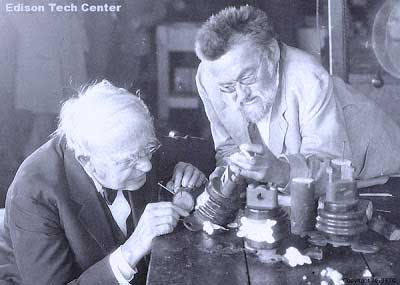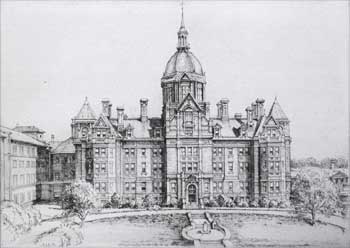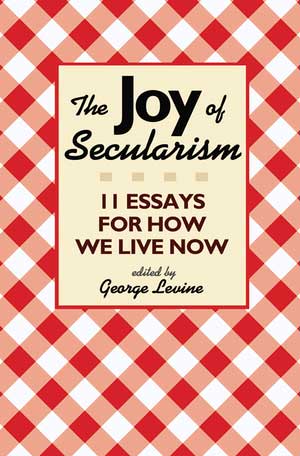
Charles P. Steinmetz [above right] stands with another freethinker, Thomas Edison [above left] and Elihu Thomson as one of the founding fathers of electricity. The devices and methods that Steinmetz developed are largely concerned with those parts of electricity that are hidden from the public eye, like the invention of generators that produce electricity as well as the transformers sitting powerfully quiet in their little houses outside generating stations. Few have wondered why the high-tension lines strung on tall steel towers are seldom damaged by lightning, but again we can thank Steinmetz for that. Without Steinmetzʼs work, electricity would be about half as useful as it is. Also, Dr. Steinmetzʼs tale of escape from Prussia, battle with polio, and rise to fame in the U.S. is a classic story of survival and success.
Toward the end of his life he was asked increasingly about his religious beliefs, and he even shared an extended conversation with noted Christian fundamentalist William Jennings Bryan. More on that aspect of his life can be read below.
Key Points:
One of the Pioneers of AC Power. Steinmetz figured out the mathematics involved in hysteresis. Hysteresis loops show the behavior of magnetism in materials. Understanding magnetism in iron cores was and is still key to design of motors, generators, ballasts and other electrical devices. Steinmetz figured out the great mystery that has stumped all the greats of the time (Thomson, Tesla, Westinghouse, Shallenberger, Edison).
Became an icon as the star engineer of General Electric in the Alternating Current Age. Founder of the GE Research Lab (now GE Global Research).
Distinguished Professor at Union College.
Helped many researchers achieve success on numerous technologies without claiming credit or collecting many patents for himself.
A believer in socialism, he thought that through automation in factories and in our personal lives (appliances) that we could eliminate the need for ‘serfs’ doing manual labor and that governments or companies could share the profits gained from automation to support the freed ‘slaves’ of feudal systems. Little did he know that increased profits from automation benefit stock share holders most of whom are already wealthy and unwilling to share that wealth, therefore the profits do not benefit the poor but have simply made the rich richer.
Steinmetz and the Ministers
Inevitably the reporters began to ask Steinmetz for his religious articles of faith. Steinmetz in his opinions never attacked anyone. He didnʼt care enough, and definite attack was a weapon which he never used. So the ministers welcomed his comments and never denounced him as an atheist. One liberal denominational magazine, the Unitarian Christian Register, even asked him to write two articles for it on his beliefs. These articles drew the inevitable line between scientific weighing of evidence and religious taking on authority but they did it in so conciliating a way that no one got angry. Steinmetz gave to religion that minute loophole which is all it needs to ask.
“There is,” said Steinmetz, “no evidence outside of science for God, immortality, and similar conceptions,and there is evidence against these conceptions in science, and science has justified its methods and conclusions by the work it has accomplished.
“But it is hard for man to get along without belief in these conceptions. We may get along without a God but not without immortality. Our self-conceit dislikes to place so little value on ourselves, our knowledge, our skill, experience—in short our Ego to concede that all this is merely a function of the biochemical process of life which will utterly cease and vanish with the disintegration of the protoplasm of the body by death.
“But all conclusions of science depend on our observation by means of the senses. Religion deals with the infinite which cannot be conceived by the senses. Also we reason by means of logic, whose rules are only thought to be true because of experience.
“This, the negative answer of science on the question whether there are conceptive entities of infinite character, as infinite in time and space, immortality of the Ego, God, etc., is not conclusive, and the question is as open as before.
“There can be no scientific foundation of religion, and belief must always remain the foundation of religion, while that of science is logical reasoning from facts, that is, sense conception. All that he can say is that the two, science and religion, are not necessarily incompatible, but are different and unrelated activities of the human mind.”
An Insulated Conversation
Steinmetzʼs tour of speech-making carried him to nearly every town of importance on the Pacific Coast, and everywhere he was greeted with the same enthusiasm. The papers ran almost verbatim stories of his addresses and editorial after editorial appeared in praise of the man who had made hydro-electric power, which in turn had made the Pacific Coast. They take their electricity very seriously out there. It largely replaces coal and the people are duly grateful to the men who make it possible.
On the train back to Chicago he had an interesting encounter. William Jennings Bryan was on board and asked to meet him. Steinmetz was sitting alone in his stateroom looking out of the window when Bryan entered. He at once recognized the familiar face of the pseudo-statesman with the light of fanaticism burning in his eyes. He greeted him warmly and Bryan immediately broached the matter nearest his heart—the only matter which really interested him. He was looking for sentimental loopholes in Steinmetzʼs disbelief.
Bryan in private with no others present to whom he could orate was very different from Bryan on the public platform. He deplored disbelief in his rather simple-minded God but he realized there was no use displaying his feelings when he had no audience which could be induced by appeals to emotion to sympathize with him. So the discussion was calm and reasonable. Steinmetz had nothing to lose by frankness and Bryan had nothing to gain by emphasis.
Steinmetz enjoyed hugely this meeting with the leader of all that was silly in religion and politics but for the life of him he couldnʼt develop any antagonism.
Bryan was so pleasant and conciliating. They talked for a long time, coming to no agreement on anything but discounting rather than opposing each otherʼs opinions because there was no one else there to hear them disagree.
Bryan asked most of the questions, presumably because Steinmetz realized that there was no use trying to get facts, the only things which interested him, out of a reservoir which contained nothing but sentiment. Bryan was not interested in facts and Steinmetz presumably had as large a stock of sentiment as any man.
Pleasantly and reasonably Steinmetz explained the position of the orthodox scientist. He granted that the inherent irrationality of human nature left some distant field for religion but disclaimed any desire to explore that field for himself. He advocated the study of the Bible by children, for he considered it a great book and one containing remarkably little religion.
Bryan listened politely enough, rocklike in his conviction that science was a fraud and revelation the only true knowledge. The two parted in a friendly state of mind, Steinmetz to return to his somewhat dusty test tubes and Bryan to continue tilling the sterile soil of rural faith.
This meeting with Bryan is a fitting last episode in the life of the enthusiastic little scientist. His useful work was almost over now and he could afford to smile indulgently at those human weaknesses which would have aroused him to fury in earlier years. So on parting he pressed warmly the hand of the Great Mogul of bucolic bigotry who was shortly to meet his Leipsig at Madison Square Garden and his Waterloo at Dayton, Tennessee.
The End
There isnʼt much more to fell. Steinmetzʼs life is nearly over now. He is fifty-eight and his body has decided to stop running. All considered, it did remarkably well to keep going so long. At least it nourished the brain during the vital years which bore such important scientific fruit. If it had been looking for excuses it could have found plenty. Every life process had to run in zigzags.
The Pacific Coast trip was the last effort the body was able to complete. On his return to Schenectady Steinmetz sank rapidly. He found it difficult to walk from the train to the taxi and when he reached home the doctor told him to stay in bed awhile and rest.
Perhaps he recognized the death sentence so gently pronounced. Probably he did not. At any rate he stayed quietly in his room, protesting now and then because he couldnʼt go to his laboratory, but devouring scientific literature as greedily as ever.
One morning about breakfast time Hayden went up to see him. Steinmetz was awake and cheerful but he seemed uncomfortable. Hayden told him to take his heart medicine. Heʼd bring him his breakfast presently.
“Keep still. Donʼt try to do anything.”
“All right,” said Steinmetz, settling himself back on the pillow. “Iʼll lie down.” Those were his last words.
Presently up came little Billy Hayden with the breakfast tray. He found Steinmetz lying as peacefully as ever, but dead. His heart had stopped. On his face was no sign of pain or surprise. He had died as naturally as an electric motor. The current was cut off. The motor lost momentum, ran slower, and stopped. That was all. Wonderfully soon the news reached the General Electric offices and the officials of the company came up in a body to pay their respects. Telegrams began to arrive from all over the country. Scientific societies, electrical companies, and plain individuals at home and abroad sent their last thanks to the man who had made their work so much easier to do.
The funeral was almost a state function. Steinmetzʼs name had penetrated to the most preoccupied minds and everyone high and low came to see him buried. How Steinmetz would have loved it all I The reporters. The lieutenant governor. The president and chairman of the company. Scientists and magnates in flocks. All genuinely sorry and genuinely worshipful as they carried the small, light coffin to the graveyard.
SOURCE: Loki: The Life of Charles Proteus Steinmetz by Jonathan Norton Leonard, New York: Doubleday, Doran and Company Inc., 1932
See also,



